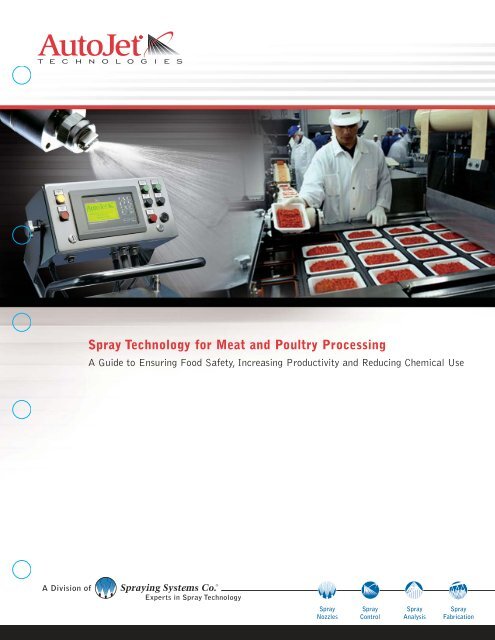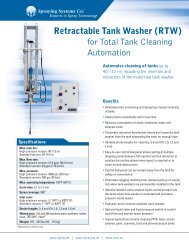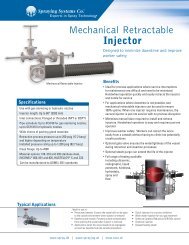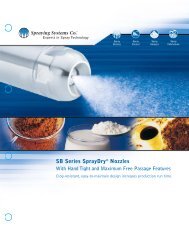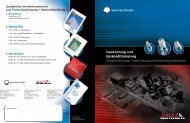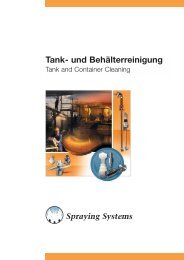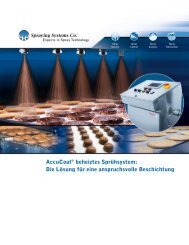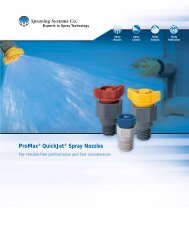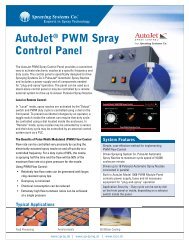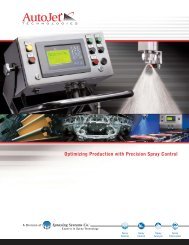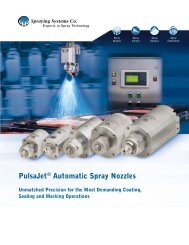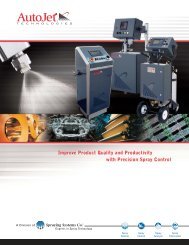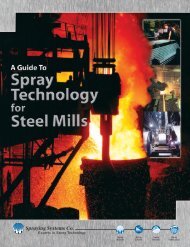Successful pathogen protection - Spraying Systems Deutschland ...
Successful pathogen protection - Spraying Systems Deutschland ...
Successful pathogen protection - Spraying Systems Deutschland ...
You also want an ePaper? Increase the reach of your titles
YUMPU automatically turns print PDFs into web optimized ePapers that Google loves.
A Division of<br />
Spray Technology for Meat and Poultry Processing<br />
A Guide to Ensuring Food Safety, Increasing Productivity and Reducing Chemical Use<br />
Experts in Spray Technology<br />
Spray<br />
Nozzles<br />
Spray<br />
Control<br />
Spray<br />
Analysis<br />
Spray<br />
Fabrication
<strong>Successful</strong> <strong>pathogen</strong> <strong>protection</strong> — a three-point approach<br />
Meat and poultry processors have a common fundamental goal —<br />
to ensure the highest level of food safety possible while minimizing production costs.<br />
To meet that goal, you may be facing some of these challenges:<br />
• Reducing microbe counts and extending product shelf life without altering taste<br />
• Minimizing chemical costs without compromising food safety<br />
• Validating safety programs<br />
Overcoming these challenges requires expertise in food production processes, chemistry<br />
and application technology. These three disciplines must work in unison to maximize<br />
the impact of anti-<strong>pathogen</strong> strategies.<br />
Process Criteria<br />
Processors develop HACCP plans and SSOPs based<br />
on their in-depth knowledge of their processing<br />
lines. But, they can benefit from partnering<br />
with chemical and application professionals<br />
to improve advanced <strong>pathogen</strong> control<br />
and line efficiency.<br />
Chemistry<br />
2<br />
Food microbiologists<br />
and chemical suppliers have<br />
developed safe and effective<br />
chemicals to destroy <strong>pathogen</strong>s.<br />
Experts from chemical companies<br />
provide valuable counsel on the<br />
many factors that affect the<br />
“kill rate” of antimicrobial agents.<br />
1<br />
Maximum<br />
Pathogen<br />
Protection<br />
3<br />
Application Technology<br />
Even the most technically advanced chemicals<br />
cannot prevent <strong>pathogen</strong> “grow out” if they<br />
are not applied accurately. Yet determining<br />
the most effective method for delivering<br />
chemicals to the product<br />
is too often overlooked.<br />
Advanced spray technology plays a critical<br />
role in applying antimicrobial chemistry<br />
• Increased product and process quality. Automated spray control<br />
systems adjust chemical application for varying line speeds and<br />
product weights quickly and accurately, eliminating human error.<br />
• Reduced chemical usage. Automated spray control systems<br />
ensure on-target application of coatings every time, reducing<br />
overall chemical usage, preventing overspray and eliminating<br />
packaging sealing problems.<br />
• Verified application of antimicrobial agents. Automated spray<br />
control systems confirm spray application of critical coatings<br />
and log chemical usage for easier compliance.<br />
For proven spray system solutions that can<br />
improve your plant’s food safety and productivity,<br />
turn to AutoJet Technologies.
Automated systems consistently and reliably apply food coatings<br />
Optimize the performance of <strong>Spraying</strong> <strong>Systems</strong> Co.<br />
automatic spray nozzles with AutoJet ® Spray <strong>Systems</strong><br />
• AutoJet Spray Controllers are equipped with on-board application software for fast production start-up<br />
• Advanced timing control ensures on-target application of chemicals every time<br />
• Multiple levels of password <strong>protection</strong> reduce operator intervention<br />
• Alarms and warnings notify operators or stop the system should problems occur<br />
• Maintenance and troubleshooting screens are available<br />
to quickly isolate problems<br />
Reduce chemical consumption with automatic spray nozzles<br />
PulsaJet ® Automatic Spray Nozzles provide accurate spray placement<br />
and exceptional spray pattern integrity in high-speed and low capacity<br />
meat and poultry processing spray applications.<br />
• High-speed cycling, up to 10,000 times per minute, enables faster<br />
line speeds and increased productivity<br />
• Pulse Width Modulation, very fast on-off operation, provides precise control<br />
of flow rate by regulating the time that the nozzle sprays<br />
– Provides lower flow rates with clog-resistant larger spray tips<br />
– Provides a high turndown ratio — a wide range<br />
of flow rates available from a single tip<br />
– Minimizes overspray and saves chemical consumption<br />
• Compact design with all wear parts easily accessible<br />
from the front for minimum maintenance downtime<br />
<strong>Spraying</strong> <strong>Systems</strong> Co. offers a broad range<br />
of automatic spray nozzles to meet your<br />
application requirements.<br />
Validate post-lethality interventions<br />
using SprayCheck sensors<br />
Here’s how AutoJet Spray <strong>Systems</strong> can verify the<br />
application of chemicals to make your food safety<br />
process validation easier<br />
• A miniature optical sensor mounted near<br />
the nozzle orifice detects a spray pattern<br />
• “Flow” signals sent by the AutoJet Spray Controller are confirmed with<br />
“spray present” signals from the SprayCheck sensor to verify spray application<br />
– Each spray cycle is documented<br />
– “No-spray present” signals can generate alarms or activate<br />
special marking of non-conforming packages<br />
PulsaJet automatic nozzle<br />
with SprayCheck sensor<br />
Request more information on<br />
our spray solutions for meat<br />
and poultry processing.<br />
See the back cover for details.
Five examples of AutoJet ® spray solutions that ensure safety, increase<br />
RTE meat processor improves<br />
kill rate and dramatically reduces<br />
chemical consumption<br />
Problem: A ready-to-eat meat processor<br />
needed to accurately spray an antimicrobial<br />
agent into container cavities prior to filling<br />
and vacuum sealing.<br />
Solution: An AutoJet Spray System using<br />
multiple PulsaJet ® Automatic Spray Nozzles<br />
sprays low doses of antimicrobial agents<br />
into multiple cavities prior to product<br />
insertion. An AutoJet Spray Controller uses<br />
a trigger signal from an indexing conveyor<br />
to activate the spray during the conveyor’s<br />
dwell time. The spray controller also<br />
monitors pumps and flow sensors to<br />
confirm proper flow rates for each<br />
spray nozzle. Unacceptable flow<br />
conditions trigger fault messages<br />
and system shutdown.<br />
This method has proven more effective<br />
and economical than chemical baths<br />
or direct spraying, with <strong>pathogen</strong><br />
reductions of greater than 6 log10<br />
and chemical savings estimated<br />
at more than US$1,000,000 per year.<br />
Case-ready poultry processor<br />
eliminates packaging problems<br />
and verifies antimicrobial application<br />
Problem: A poultry processor needed to spray<br />
an antimicrobial agent in packages without wetting the lip of the product tray.<br />
The volume of solution had to be precisely adjusted based on portion size and the<br />
processor required verification that the antimicrobial was applied to each package.<br />
Solution: An AutoJet Spray System prevents overspray by using the packaging machine’s<br />
encoder signal and a proximity sensor to precisely control the timing of a PulsaJet<br />
Automatic Spray Nozzle. The system allows operators to quickly select the proper<br />
spray volume from a menu based on portion size and verifies that chemicals are<br />
applied to each package using SprayCheck sensors for validation purposes.
productivity and reduce chemical use<br />
Ready meal processor minimizes overspray<br />
on oval targets with advanced spray shaping<br />
Problem: A processor of ready meals and processed meats<br />
needed to spray a viscous water and caramel coating onto<br />
oval-shaped molds filled with pâté. The previous system<br />
produced a flat fan pattern which sprayed a great deal of<br />
coating on the outside of the mold.<br />
Packaged foods producer extends<br />
shelf life of frozen meatballs<br />
Problem: A major meat processor was experiencing product quality<br />
problems due to their chemical application process. The manual<br />
process resulted in chemical waste, inconsistent coverage and mold<br />
on their frozen meatballs.<br />
Solution: An AutoJet Modular Spray System using PulsaJet<br />
Automatic Spray Nozzles evenly coats the meatballs with lactic<br />
acid after cooking and prior to freezing. The spray controller can<br />
automatically adjust flow rate for variations in line speed, so a<br />
constant application rate is maintained. Uniform coverage with<br />
lactic acid extends the product’s shelf life. The automated system<br />
also greatly reduces overspray and chemical usage.<br />
Case-ready meat processor improves product quality of ground beef chubs<br />
Problem: Responding to customer demands, a major case-ready meat processor needed<br />
to improve the consistency of their seasoning of ground beef chubs prior to packaging.<br />
Solution: An AutoJet Spray Controller quickly adjusts the<br />
atomizing air pressure to a flat spray nozzle from 3 psi to 15 psi<br />
and then back to 3 psi, varying the spray pattern’s fan width.<br />
By carefully timing the pressure adjustments with the motion of<br />
the molds, an intermittent oval coverage is created, minimizing<br />
the waste produced by other spray systems. The external mix<br />
spray setups used with the PulsaJet Automatic Spray Nozzles<br />
handle the viscous coating without clogging.<br />
Solution: An AutoJet Spray Flavoring System maintains a constant application rate of .25% rosemary<br />
seasoning by weight, regardless of line speed changes. Photoeye sensors detect the presence of ground<br />
beef chubs and trigger intermittent sprays from PulsaJet Automatic Spray Nozzles, eliminating over-application<br />
of the seasoning mix. Stainless steel flow meters confirm the flow rate to the AutoJet Spray Controller and<br />
alarms are programmed to notify operators if the system does not maintain the desired flow rate.<br />
In addition to satisfying their customer’s product quality demands, the AutoJet Spray System provided<br />
the processor with a payback estimated at one year based solely on reduced chemical usage.
Other helpful resources:<br />
A Guide to Spray Technology<br />
for Food Processing<br />
Bulletin No. 524B<br />
Informative guide summarizes<br />
the latest spray technologies for<br />
coating, spray drying, cooling,<br />
humidifying and packaging.<br />
PulsaJet ® 10,000<br />
Automatic Spray Nozzle<br />
Bulletin No. 551<br />
Includes features, benefits and<br />
specifications of our new<br />
automatic spray nozzle. PulsaJet<br />
nozzles use extremely fast on-off<br />
operation, up to 10,000 cycles<br />
per minute, to precisely control<br />
flow rate and reduce overspray.<br />
A Guide to Safe and<br />
Effective Sanitation<br />
Catalog 40<br />
Features innovative spray products<br />
for food processors. Topics include<br />
CIP solutions, automated tank<br />
washing, manual cleaning,<br />
equipment cleaning and blow off.<br />
A Division of<br />
North America:<br />
Europe:<br />
P.O. Box 7901<br />
Wheaton, IL 60189-7901 USA<br />
Tel: 1.866.321.2250<br />
Fax: 1.630.665.9462<br />
E-mail: info@autojet.com<br />
Buchtenstraat 2<br />
B-9051 Gent (Sint-Denijs-Westrem) Belgium<br />
Tel: +32 (0) 92.44.65.65<br />
Fax: +32 (0) 92.44.65.66<br />
E-mail: info@autojet.be<br />
www.autojet.com<br />
AutoJet ® Modular Spray System<br />
Bulletin No. AT104B<br />
Details the features, specifications<br />
and options of our most<br />
cost-effective spray system<br />
to incorporate advanced<br />
spray control.<br />
Optimizing System Performance<br />
with Precision Spray Control<br />
Bulletin No. AT103B<br />
Provides an overview of the<br />
benefits of automated spray<br />
systems. Included are application<br />
examples that show how to reduce<br />
overspray, improve product quality,<br />
increase throughput and improve<br />
regulatory compliance.<br />
Advancing Spray Technology<br />
Through Consulting, Prototyping<br />
and Testing<br />
Bulletin No. 520C<br />
Discusses the role of spray analysis<br />
and research methodologies in<br />
process improvement. Case studies<br />
demonstrate how spray analysis has<br />
saved manufacturers thousands of dollars.


